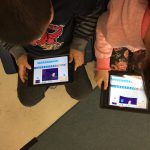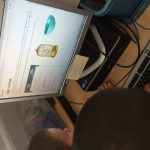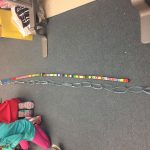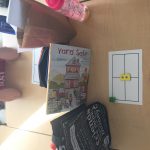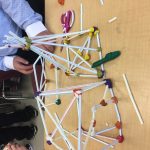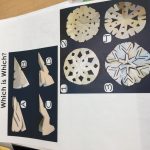With Grade 2 and Grade 4 learning buddies, we created and collected a variety of tasks and opportunities to explore and develop math confidence. Through these tasks, our goal was to further build a supportive math community with a variety of opportunities for students to ask questions and defend their ideas.
This project aim is to encourage risk-taking, collaboration, critical-thinking and questioning skills in both students and teachers. By working with students from different grades, we fostered a stronger math community that extends further than one classroom. The students can see value in listening and learning from each other and the power of collaboration.
Team Members
Laura Suppa
York Region District School Board
Maryanne Sawyer
York Region District School Board
Professional Learning Goals
- Further understood how to reduce math anxiety through engaging and meaningful tasks
- Developed a deeper understanding of hands-on exploration, inquiry and STEM to build math skills, concepts and thinking
- Gave opportunity for students to transfer engagement from tasks to challenging math concepts
- Created a supportive math community where every student felt safe and their opinions were valued
- Expanded our mathematical knowledge by participating in a variety of professional development opportunities
Activities and Resources
Each activity has a focus, task description and materials/resources needed.
Growth Mindset and Community
- Learning from Others
Introduction to the project and learning goals. Through a read-aloud, students were reminded of the importance of growth mindset. They also had to chance to appreciate each other and acknowledge that not everyone’s ideas look or sound the same.
Young Frank Architect (picture book)
- Green Screen Collaborative Work
To develop collaboration, students worked together on a brand new task (Green Screen) to explore common interests. This gave students an opportunity to have fun, persevere when the photos didn’t work, and get to know their Buddies. As teachers, we observed relationships and made changes where necessary.
Green tablecloth (Dollarama Thick Ones)
iPad
Do Ink app
Background images
First Exposure to STEM
- Cardboard Explore
Using cardboard boxes and any other materials they could find in the classroom, students created cardboard creations of their choice. They were introduced to the planning process. They showed collaboration, problem-solving and gave students a chance to celebrate small successes.
Cardboard boxes
Tape
Scissors
Markers
Classroom materials
- LEGO STEM Challenge Cards
Using the LEGO task cards from Playdough to Plato, students were given the chance to re-create their own interpretations of the prompt (e.g., build a triangle that is the same length on two sides, or make something that is symmetrical). This embedded some math concepts that we were learning in class. We also gave students an opportunity to observe and value the design choices of their classmates through a Gallery Walk.
LEGO task cards
LEGO
- Toilet Paper Rolls & Pencils
Using toilet paper rolls, pencils and a hole puncher, students created/built a structure. Students took this time to be creative and model existing landmarks such as The Leaning Tower of Pisa and animals such as a horse.
Toilet paper rolls
Single hole puncher
Pencils
https://nevershushed.com/2015/08/19/homemade-tinker-toys/
Math Focus and Confidence Building
- Number Patterns exploration
Connecting to our learning in math, students explored patterns in different contents. Using the nrich math site resources as a guide, students persevered and worked through the challenges collaboratively. Students then had an opportunity to create their own math pattern activities. - Buzzy Bee http://nrich.maths.org/194&part=note
- Next Domino http://nrich.maths.org/168
Domino Number Patterns http://nrich.maths.org/225
Dominos - 3D Structures
Connecting to our learning in math and with their buddies, students explored and identified various 3D figures in our environment. They then had an opportunity to build their own 3D structures with straws and plasticine that included many 3D shapes.
Straws
Plasticine
3D shape models
Coding
- Hour of Code
Through a variety of manual and digital coding challenges, students explored the concepts of spatial sense. Students were encouraged to use math vocabulary while building a course for their Bee-Bots. Students also used the hour of code website and iPad apps to explore digital coding.
Spatial sense
Manual coding – Gingerbread https://drive.google.com/drive/search?q=gingerbread
iPad apps: Explore, ScratchJr, Hopscotch, Bee-Bots, etc.
hourofcode.org www.code.org
Break the Code (Literacy Connection)
STEM
- Snow Fort Challenge**
Using GOOS Paper, students were challenged to build a stable structure that would act like a snow fort with only 21 snowballs. We anticipated students building a shrinking pattern. The students were to plan their idea and then build.
Patterning and geometry
Paper
Tape
Planning sheet
Spatial Sense
- SnowFlake Challenge
Starting with Snowflake Bentley, students were introduced to the story of where a snowflake came from. They also learned about the uniqueness of each snowflake and began to make some math connections. Students were then given images of folded snowflakes and had to justify and defend what it would look like open with their learning buddies. On the following session, students were then challenged to create snowflakes with specific features (e.g., six-sided, hole in the middle, star in the middle, eight-sided). - Paper, scissors, planning sheet, minds on picture prompt and tasks https://drive.google.com/drive/folders/0B0cKukSTcXW1cWtaVGxDaWR3MX, Snowflake Bentley (bookflix)
STEM and Math
- Tangram Challenge
We exposed the students an image of a rooster made of tangrams. We engaged in an activity called “Where’s the Math,” where students shared their thinking about any math strand that they could connect with in the picture.
We then gave each group their own set of tangrams to explore creating shapes and figures. We prompted them to create a perfect square, various animals, and designs of their choice.
Students then traced their creations onto grid chart paper. Their goal was to determine the approximate area and perimeter of each creation. They gave general statements of bigger versus smaller and determined that all creations gave the same area. They also determined what 2D shapes were found within their figures.
This was then assessed in an exit ticket where students transferred their learning to another task individually.
Spatial Sense
- Task Cards and Challenges
https://drive.google.com/drive/folders/0B0cKukSTcXW1cWtaVGxDaWR3MXM
Tangrams ( cut outs)
Minds-on
https://docs.google.com/document/d/1cVrsw9eAutneDP6EGzH9vXFft0EAPCV9o_U08yEzipo/edit
Perimeter & Area Exploration
Does one tangram design have a bigger or smaller area than another? How do you know?
What about the perimeter? Does the perimeter change when the design changes?
Grid paper
Tangram (cut-outs)
https://docs.google.com/document/d/1uUIdReeI70L1XLa9X5lhunvxtVCsyLkR64vHM9BWuPg/edit
Spatial Sense
- Build it in Your Mind
Again, we started with a Where’s the Math activity. They were encouraged to think perspective and viewpoints. The goal was to help bring out math vocabulary (above, below, to the left, etc.).
Using the resource, Taking Shape, we then read out of description of how to build a specific tower. Students were then asked to identify which tower (out of four) matched the oral description.
Partners then created their own towers and played the Barrier Challenge game. Each partner used descriptive language to teach their partner how to build their tower.
This was then assessed in an exit ticket where students transferred their learning to another task individually.
- Spatial reasoning and decomposing 3D objectives
Minds-on
https://docs.google.com/document/d/1qqdXZIIryL6dLKhVz4wPD4FlAbeqUvEcJnM3qaZRGVg/edit
Page 160 of Taking Shape – Moss, Bruce, Caswell et al.
- Snap cubes
- Task sequence cards
STEM, Math
- Build a Balance Scale Project
Told students that they will be building a balance device to measure mass. Then we asked to research and explore different ways to create homemade balance scales. Partners came up with a plan and recorded it on large paper with a list of materials to carry out their plan.
Students then had an opportunity to Gallery Walk through the other devices and test them out.
They then reflected on how they can improve theirs for next time, and the key features needed in a balance device.
- Materials needed:
Planning sheets
Laptop
iPad
Straws
Hangers
Elastics
Bowls
String (thicker)
Hole punchers
Wood rulers
Pompom
Connectors (cardboard)
Ask students to bring in cardboard
BreakoutEDU
Work on problem-solving skills and collaboration.
Students were presented with an opportunity to participate in a digital breakout. They were introduced to the task and, in partners they had to inference, problem-solve and work together to successfully complete the challenge.
Students then took their skills from digital breakouts and applied them in a real breakout with locks, and clues around the room.
Breakouts started from pre-created resources . The last few were created with a math focus.
www.breakoutedu.com/digital
www.breakoutedu.com
Computers
Unexpected Challenges
One of our biggest challenges was knowing where to start. We took some gradual leaps at the beginning to try and facilitate growth mindsets, relationships and trust, however, we got a bit stuck in structured learning activities. As we developed confidence in ourselves, we were willing to give the students more voice and choice, with flexibility and opportunity for them to create.
Taking the time to create was another unexpected challenge. There were some challenges finding dates that worked for both us, our school and our students to take off to plan. We had to amend our dates often due to scheduling conflicts and the school environment. We learned taking half-days were often easier than full-days.
At the beginning, we were also hesitant to branch out too far. We were relating our content to what we were learning in math. In the future, we’re all for taking risks and allowing students to make those connections on their own and giving them opportunity to consolidate multiple math strands at once.
From our student feedback:
“Make it longer more, more than once a week.”
“More outside stuff.”
“More hands-on.”
“Switch up partners.”
Enhancing Student Learning and Development
We gave students a chance to give feedback on our learning buddies time together. Here are some quotes and common consensuses from the students.
What are some things that you learned in learning buddies?
“I learned how to work co-operatively.”
“That you need to sometimes look more closely and carefully.”
“Never give up.”
Describe your favourite learning buddy task?
“Finding out things with my buddy.”
“Meeting new friends.”
“Building hands-on.” – balance scale
- Exposure to new challenges – breakout rooms
Sharing
We plan to share our learning at staff meetings to help share the benefits of cross-grade learning and STEM challenges.
We have already shared with our grade teams and administration with some task ideas. The goal is to build learning buddies across both grades next year.
Plan to recap our learning via Twitter with hashtag #STEMLearningBuddies this summer.
Project Evaluation
Our main determination of success is student engagement and with that being said, “YES, our project was a success.” Students were actively engaged, involved and questioning the learning every step of the way. We would have loved to have more time with both classes together, however scheduling was sometimes hard and limited to 30 minutes/week.
One of the biggest observations we noticed was the ability for students to allow themselves to take risks and try something new and unknown. We had many hesitant students at the beginning who are now begging for learning buddy time and more challenges. Although the students may not be aware of this shift, we definitely saw growth in their abilities to preserve and collaborate.
Another piece to note is our personal success. We are also feeling confident to try more complex, less structured tasks. We have challenged our own thinking about the traditional models of learning and we are finding curriculum connections throughout. We would love to continue this journey to build on our organizational structures, our documentation of student conversations, and to look deeper at the connections between learning buddies and our math program especially in regard to assessment.
Resources Used
Various activities that were used and sometimes modified for our purposes
Lesson ideas, STEM bins, recording sheets
A great place to find digital and physical breakouts
Spatial Sense Text: Taking Shape
Building Capacity Series: Student Voice
http://www.edu.gov.on.ca/eng/literacynumeracy/inspire/research/CBS_StudentVoice.pdf
Coding website
Website with various math tasks and challenges
Resources Created
These resources will open in your browser in a new tab, or be downloaded to your computer.



